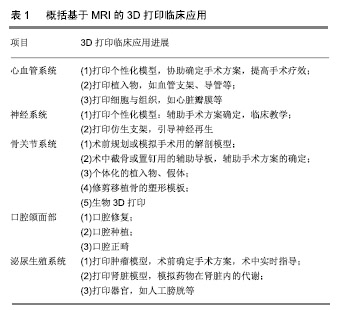| [1]Iannotti JP, Weiner S, Rodriguez E, et al. Three-dimensional imaging and templating improve glenoid implant positioning. J Bone Joint Surg Am. 2015;97(8): 651-658.[2]李盛华,邓昶,周明旺,付志斌.骨科领域精准医疗的观念?特点及价值[J].中国组织工程研究,2018,22(15):2407-2413. [3]Rengier F, Mehndiratta A, von Tengg-Kobligk H, et al. 3D printing based on imaging data: review of medical applications. Int J Comput Assist Radiol Surg. 2010;5(4): 335-341. [4]Townsend K, Pietila T. 3D printing and modeling of congenital heart defects: A technical review. Birth Defects Res. 2018; 110(13):1091-1097. [5]Mathur M, Patil P, Bove A. The role of 3D printing in structural heart disease: All that glitters is not gold. JACC Cardiovasc Imaging. 2015;8(8):987-988.[6]Huotilainen E, Jaanimets R, Salmi M, et al. Inaccuracies in additive manufactured medical skull models caused by the DICOM to STL conversion process. J Craniomaxillofac Surg. 2014;42(5):e259-e265. [7]Esses SJ, Berman P, Bloom AI, et al. Clinical applications of physical 3d models derived from mdct data and created by rapid prototyping. Am J Roentgenol. 2011;196(6): W683-W688. [8]Pearce MS, Salotti JA, Little MP, et al. Radiation exposure from CT scans in childhood and subsequent risk of leukaemia and brain tumours: a retrospective cohort study. Lancet. 2012; 380(9840):499-505. [9]Little MP, Azizova TV, Bazyka D, et al. Systematic review and meta-analysis of circulatory disease from exposure to low-level ionizing radiation and estimates of potential population mortality risks. Environ Health Perspect. 2012; 120(11):1503-1511. [10]张兆琪,徐磊. 心脏MRI的应用现状与新技术进展[J]. 磁共振成像,2013,4(3):218-225.[11]赵世华.迎接心脏磁共振成像新技术挑战[J].中国医学影像技术, 2017,33(8):1125-1128.[12]胡立伟,白凯,钟玉敏,等,磁共振成像技术在3D打印先天性心脏病建模中的应用[J].中国医学计算机成像杂志, 2016,22(4): 356-360.[13]Farooqi M, Cooper C, Chelliah A, et al. 3D printing and heart failure: the present and the future. JACC Heart Fail. 2019; 7(2):132-142.[14]Valverde I, Gomez G, Coserria JF, et al. 3D printed models for planning endovascular stenting in transverse aortic arch hypoplasia: 3D Cardiovascular Model Simulation. Catheter Cardiovasc Interv. 2015;85(6):1006-1012. [15]Ahmadian RR, Boyd AP, Scotti AM, et al. Comprehensive evaluation of aortic disease by in-vivo 4D flow MRI and 3D printing of patient-specific models: a feasibility study. J Cardiovasc Magnet Reson.2016;18(Suppl 1): P365.[16]Marks M, Alexander A, Matsumoto J, et al. Creating three dimensional models of Alzheimer’s disease. 3D Print Med. 2017;3(1):13. [17]Lin JY, Zhou ZJ, Guan JW, et al. Using three-dimensional printing to create individualized cranial nerve models for skull base tumor surgery. World Neurosurgery. 2018;120:e142-e152.[18]van de Belt TH, Nijmeijer H, Grim D, et al. Patient-Specific Actual-Size Three-Dimensional Printed Models for Patient Education in Glioma Treatment: First Experiences. World Neurosurgery. 2018;117:99-105. [19]兰青,陈爱林,张檀,等. 通过3D打印技术制备颅脑实体模型[J]. 中华医学杂志, 2016,96(30):2434-2437.[20]曲扬,艾松涛,杨飞,等. CT和MRI图像配准融合联合3D打印技术在难治性骨盆肿瘤术前规划中的应用[J]. 上海交通大学学报(医学版), 2017, 37(9):1238-1244.[21]Guenette JP, Himes N, Giannopoulos AA, et al. Computer-based vertebral tumor cryoablation planning and procedure simulation involving two cases using MRI-visible 3D Printing and advanced visualization. Am J Roentgenol. 2016;207(5):1128-1131.[22]孔金海,钱明,钟南哲,等.3D打印模型辅助骶骨脊索瘤整块切除,中华骨科杂志,2017,37(10):620-628.[23]Ma L, Zhou Y, Zhu Y, et al.3D-printed guiding templates for improved osteosarcoma resection. Scient Rep. 2016;6(1): 23335.[24]刘帅,姚庆强,田书畅,等.3D 打印截骨槽导板与定位钉导板在全膝关节置换术中的对比研究[J]. 中国骨与关节杂志,2017, 6(5): 334-339.[25]邱冰,张明娇,唐本森,等. 基于3D打印个性化手术导航模板辅助下的人工全膝关节置换[J]. 中国组织工程研究,2018,22(48): 7731-7735.[26]邱洪九, 吴毅, 王子明, 等. 3D打印导向器辅助关节镜下前交叉韧带重建术骨髓道准确性的对比研究[J].创伤外科杂志, 2018, 20(9):651-655.[27]Kortes J, Dehnad H,Kotte ANT,et al.A novel digital workflow to manufacture personalized three-dimensional-printed hollow surgical obturators after maxillectomy. Int J Oral Max Sug. 2018;47(9):1214-1218. [28]van Eijnatten M, Rijkhorst EJ, Hofman M, et al. The accuracy of ultrashort echo time MRI sequences for medical additive Manufacturing. Dentomaxillofac Radiol. 2016;45(5), 20150424.[29]Reinbacher KE, Wallner J, Kärcher H, et al. Three dimensional comparative measurement of polyurethane milled skull models based on CT and MRI data sets. J Craniomaxillofac Surg. 2012;40(8):e419-e425. [30]张海,刘钢,佟小光,等. 3D打印技术在复杂鼻颅底肿瘤手术中的应用[J]. 中华耳鼻咽喉头颈外科杂志,2018,53(10):780-784.[31]Mourits DL, Wolff T, Forouzanfar T, et al. 3D orbital reconstruction in a patient with microphthalmos and a large orbital cyst-a case report. Ophthalmic Genet. 2016;37(2): 233-237. [32]Sayed Aluwee SAZB, Zhou X, Kato H, et al. Evaluation of pre-surgical models for uterine surgery by use of three-dimensional printing and mold casting. Radiol Phys Technol. 2017;10(3):279-285. [33]Lindegaard JC, Madsen ML, Traberg A, et al. Individualised 3D printed vaginal template for MRI guided brachytherapy in locally advanced cervical cancer. Radiother Oncol.2016; 118(1):173-175. [34]Baek MH, Kim DY, Kim N, et al. Incorporating a 3-dimensional printer into the management of early-stage cervical cancer. J Surg Oncol. 2016;114(2):150-152. [35]Wu HH, Priester A, Khoshnoodi P, et al. A system using patient-specific 3D-printed molds to spatially align in vivo MRI with ex vivo MRI and whole-mount histopathology for prostate cancer research. J Magn Reson Imaging. 2019;49(1): 270-279. [36]Shin T, Ukimura O, Gill IS. Three-dimensional printed model of prostate anatomy and targeted biopsy-proven index tumor to facilitate nerve-sparing prostatectomy. Eur Urol.2016;69(2): 377-379. [37]Wake N, Chandarana H, Huang W, et al. Application of anatomically accurate, patient-specific 3D printed models from MRI data in urological oncology. Clin Radiol. 2016;71: e1-e5.[38]Rao N, Chen K, Yang Q, et al. Proof-of-Concept Study of 3-D-Printed Mold-Guided Breast-Conserving Surgery in Breast Cancer Patients. Clin Breast Cancer. 2018;18(5): e769-e772. [39]Bangeas P, Drevelegas K, Agorastou C, et al. Three-dimensional printing as an educational tool in colorectal surgery. Front Biosci (Elite Ed). 2019;11:29-37.[40]李世俊,王懿,吕艳伟,马林.3D打印技术在儿童脑部MRI教学中的应用[J].中国医学影像学杂志,2018,26(5):388-390.[41]Zheng JP, Li CZ, Chen GQ, et al. Three-Dimensional printed skull base simulation for transnasal endoscopic surgical training. World Neurosurg. 2018;111:e773-e782. [42]Sahnan K, Adegbola SO, Tozer PJ, et al. Innovation in the imaging of perianal fistula: a step towards personalised medicine. Ther Adv Gastroenterol. 2018;11:1-7. [43]陈为坚,陈奕雄,陈慧华. 基于磁共振影像重建技术的三维打印膝关节疾病模型在骨科教学中的应用[J]. 中国当代医药, 2018, 25(22):159-161.[44]陈以胜,王景景,陈旭义,等. 3D打印技术制备大鼠脊髓仿生支架的研究[J]. 中国修复重建外科杂志,2015,29(3):364-367.[45]王锦阳,黄文华. 生物3D打印的研究进展[J]. 分子影像学杂志, 2016, 39(1):44-46,62. [46]Leberfinger AN, Dinda S, Wu Y, et al. Bioprinting functional tissues. Acta Biomaterialia. 2019. [47]Murphy SV, Atala A. 3D bioprinting of tissues and organs. Nature Biotechnol. 2014;32(8): 773-785. [48]Mannoor MS, Jiang Z, James T, et al. 3D Printed bionic ears. Nano Letters. 2013;13(6): 2634-2639. [49]胡超然,邱冰.3D生物打印技术在骨组织工程中的应用[J].中国组织工程研究,2018,22(2):316-322. [50]Ripley B, Levin D, Kelil T, et al. 3D Printing from MRI data: harnessing strengths and minimizing weaknesses. J Magn Reson Imaging. 2016;45(3):635-645. |
.jpg)

.jpg)
.jpg)